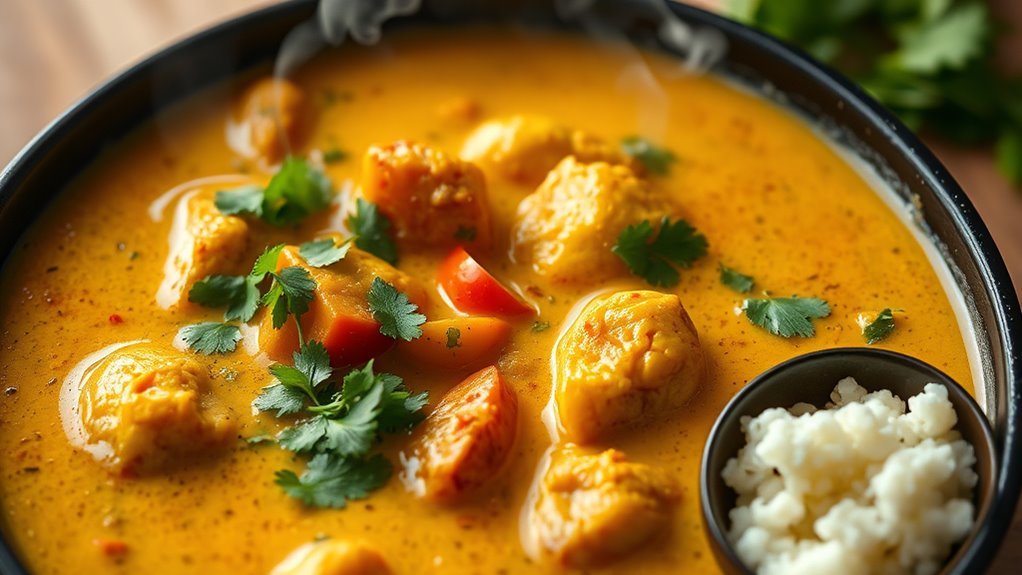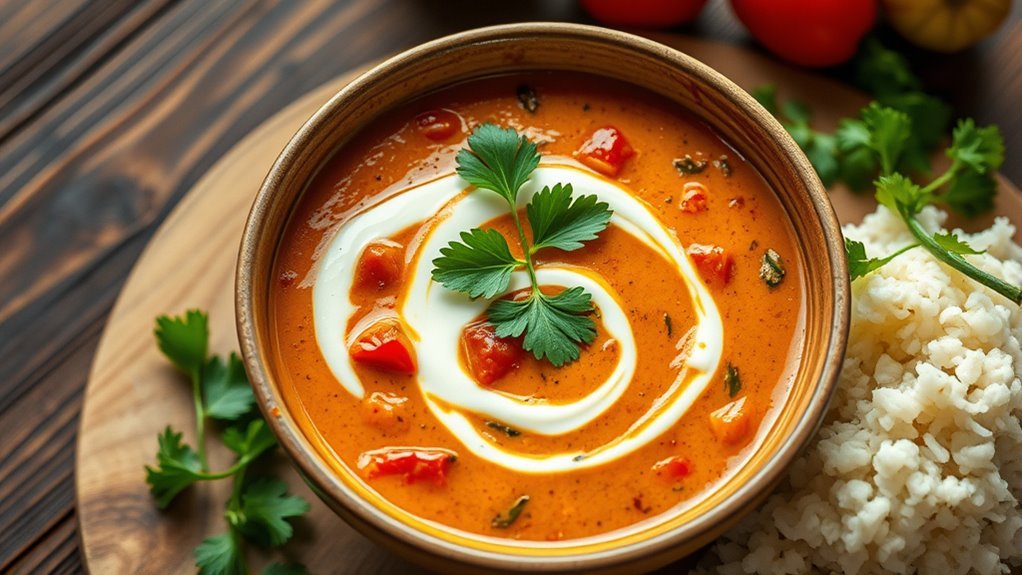Yes, curry can be keto-friendly if you make it with low-carb ingredients. Focus on veggies like spinach and cauliflower, and use coconut milk instead of high-carb sauces. You can also substitute traditional rice with cauliflower rice. Opting for proteins like chicken or shrimp will keep your dish nutritious. With the right ingredients, you can enjoy flavorful curry while maintaining ketosis. If you want more tips and recipes, there’s plenty more you can discover!
Understanding the Basics of the Keto Diet

If you’re considering the keto diet, it’s important to understand its foundational principles. At its core, the keto fundamentals involve greatly reducing carbohydrate intake while increasing fat consumption. This shift encourages your body to enter ketosis, a metabolic state where it burns fat for fuel instead of carbs. Typically, the diet principles recommend that about 70-75% of your daily calories come from fats, 20-25% from proteins, and only 5-10% from carbohydrates. This balance helps stabilize blood sugar levels and can lead to weight loss, increased energy, and improved mental clarity. However, it’s essential to focus on whole, nutrient-dense foods to guarantee you’re getting the vitamins and minerals necessary for overall health while enjoying the freedom this diet offers. Additionally, understanding the concept of macronutrient ratios is crucial for achieving optimal results on the keto diet.
Traditional Curry Ingredients and Their Carbohydrate Content

When considering if curry fits into a keto diet, it’s crucial to look at traditional ingredients and their carbohydrate content. Common curry vegetables can be lower in carbs, while the sauces often contain sugars and thickeners that may impact your carb count. Additionally, the protein sources used in curries vary, and understanding their contributions can help you make informed choices.
Common Curry Vegetables
Curry is a vibrant dish that often features a variety of vegetables, each contributing unique flavors and textures while varying in carbohydrate content. By incorporating low carb vegetables, you can enjoy the numerous curry vegetable benefits without compromising your dietary goals. Here’s a quick look at some common curry vegetables and their carbohydrate content:
| Vegetable | Carbs per 100g | Benefits |
|---|---|---|
| Spinach | 3.6g | Rich in iron and vitamins |
| Cauliflower | 5g | High in fiber, low in calories |
| Zucchini | 3.1g | Hydrating; good for digestion |
| Bell Peppers | 6g | Packed with antioxidants |
Choosing the right vegetables allows you to savor the flavors of curry while keeping carbs in check.
Curry Sauces Overview
While many people enjoy the rich flavors of curry, it’s important to contemplate the sauces that often accompany these dishes, as they can remarkably impact your carbohydrate intake. Traditional curry sauces, typically made with tomatoes, coconut milk, or yogurt, can vary greatly in their carb content. For example, coconut milk adds creaminess but can also elevate carbs if used in excess. When exploring curry flavor profiles, consider that the choice of spices and cooking techniques—such as simmering or sautéing—can affect overall nutrition. To stay aligned with keto principles, opting for lower-carb ingredients, like heavy cream instead of coconut milk, can help you enjoy the deliciousness of curry without the added carbs.
Protein Sources Used
Although many traditional curry recipes feature a variety of protein sources, the carbohydrate content of these ingredients can differ markedly. For those following a keto diet, chicken options like tandoori or butter chicken are often ideal, as they’re low in carbs and high in protein. On the other hand, tofu varieties, such as firm or extra-firm tofu, are also popular for plant-based diets and typically contain minimal carbohydrates, making them suitable for keto enthusiasts. However, be cautious with any added sauces or marinades, as they can increase carb counts. Ultimately, understanding the carbohydrate content of your chosen protein sources allows you to enjoy delicious curry while staying aligned with your dietary goals. Additionally, incorporating high protein content into your meals can help maintain muscle mass during ketosis.
Low-Carb Curry Variations to Try

If you’re looking to enjoy flavorful dishes without the carbs, exploring low-carb curry variations can be a delightful solution. You can create a rich coconut curry using cauliflower rice instead of traditional grains, which keeps the carb count low. Incorporate low carb spices like turmeric, cumin, and coriander for that authentic flavor. Consider using chicken, shrimp, or tofu as your protein source, pairing it with fresh vegetables like spinach or bell peppers. To elevate your dish, try keto-friendly toppings such as avocado slices, cilantro, or a dollop of Greek yogurt. These variations not only satisfy your taste buds but also align perfectly with your low-carb lifestyle, allowing you the freedom to indulge without guilt. Adding leafy greens like kale or arugula can enhance the nutritional value of your curry while keeping it keto-friendly.
How to Make Curry Keto-Friendly
To make your curry keto-friendly, start by choosing low-carb ingredients like cauliflower, zucchini, or leafy greens instead of traditional starchy vegetables. You can also replace high-carb sauces with options like coconut milk or homemade spice blends to keep the flavor intact. Finally, adding healthy fats, such as coconut oil or ghee, will enhance the richness while supporting your keto goals. Consider incorporating high-quality fats into your recipes to further align with keto principles.
Choose Low-Carb Ingredients
When you’re looking to make a curry keto-friendly, choosing low-carb ingredients is vital for keeping your carb count in check. Start by incorporating low carb vegetables like spinach, zucchini, or cauliflower, which add bulk and nutrients without unnecessary carbs. You can also consider using coconut milk instead of traditional dairy, as it’s creamy and low in carbs. Don’t forget to spice things up! Keto spices such as turmeric, cumin, and coriander not only enhance flavor but also offer health benefits. By focusing on these low-carb ingredients, you’ll guarantee your curry remains delicious and satisfying while aligning with your keto lifestyle. These choices allow you to enjoy your favorite dish without compromising your dietary goals. Additionally, using healthy fats like avocado or olive oil can elevate the taste and nutritional profile of your curry.
Replace High-Carb Sauces
After selecting low-carb ingredients, the next step in making a keto-friendly curry involves replacing high-carb sauces commonly used in traditional recipes. Many sauces, like sweetened soy or traditional curry pastes, can pack in hidden sugars. Instead, consider using alternatives that maintain that rich curry flavor. Coconut milk is an excellent base, providing creaminess without the carbs. You can also use homemade curry pastes made from fresh herbs and spices, ensuring you control the ingredients. For a tangy kick, opt for low-sugar tomato puree or tamari instead of soy sauce. By choosing these sauce alternatives, you can create a satisfying curry that aligns with your keto lifestyle while enjoying every flavorful bite. Additionally, using low-carb alternatives like coconut aminos can help minimize sugar content while enhancing flavor.
Add Healthy Fats
Incorporating healthy fats is essential for transforming your curry into a keto-friendly dish, as they not only enhance flavor but also help keep you satiated. Here are some great options to evaluate:
- Coconut Oil: Rich in medium-chain triglycerides (MCTs), this oil can boost your energy levels.
- Ghee: This clarified butter is lactose-free and adds a rich, nutty flavor, making it a healthy fat source that aligns with keto principles.
- Avocado Oil: With a high smoke point, it’s perfect for frying and drizzling.
- Nut Butters: Almond or cashew butter can add creaminess and depth to your curry.
Substitutes for High-Carb Ingredients in Curry
While traditional curry recipes often feature high-carb ingredients like potatoes, rice, and certain legumes, you can easily substitute these components to create a keto-friendly version. For instance, cauliflower rice is a fantastic substitute for regular rice, providing a similar texture without the carbs. Instead of potatoes, try using turnips or radishes, which can mimic the starchy feel while keeping your carb count low. You can also replace legumes with nuts or seeds for added crunch and healthy fats. Don’t forget to maintain those rich curry flavors by using your favorite curry flavorings, like turmeric, cumin, and coriander. These ingredient swaps can help you enjoy delicious curries without compromising your ketogenic lifestyle. Additionally, being mindful of rice’s role in the diet is essential for staying in ketosis.
Meal Prep Tips for Keto Curry
Preparing keto curry ahead of time can save you both time and effort during busy weeks. With a little planning, you can enjoy delicious meals while sticking to your keto lifestyle. Here are some meal prep tips for your keto curry:
- Batch cook: Make a large batch of curry and portion it into individual servings for easy access throughout the week.
- Use airtight containers: Proper curry storage is essential; choose containers that keep your meals fresh and prevent spills.
- Freeze extras: If you’ve made too much, freeze portions for later. They can last up to three months.
- Prep ingredients ahead: Chop veggies and marinate proteins in advance to streamline your cooking process.
These tips will help you enjoy keto curry effortlessly!
Popular Curry Dishes and Their Keto Compatibility
When you’re charting your keto journey, understanding the compatibility of popular curry dishes with your dietary goals is essential. Traditional curries often include ingredients like potatoes and rice, which are high in carbs. However, many curry dishes can be modified to fit a keto lifestyle. For instance, chicken curry made with coconut milk and a variety of curry spices can be delicious and low in carbs. The origins of curry date back centuries, and its versatility means you can experiment with different meats and low-carb vegetables. Seafood curries are also excellent choices, providing healthy fats and proteins. Just be mindful of added sugars or thickening agents that can sneak in. With a little creativity, you can enjoy curry without compromising your keto plan, as maintaining low carb intake is essential for achieving health goals on keto.
Enjoying Curry While Maintaining Ketosis
Enjoying curry while staying in ketosis can be both satisfying and flavorful. You can easily incorporate curry into your keto meal prep by following these tips:
- Choose Low-Carb Veggies: Use cauliflower, zucchini, or spinach as your base.
- Opt for Coconut Milk: It adds creaminess without unnecessary carbs.
- Incorporate Protein: Chicken, shrimp, or tofu can make your curry filling and nutritious.
- Use Keto-Friendly Curry Flavor Enhancers: Experiment with spices like turmeric, cumin, and ginger to elevate taste without carbs.
Frequently Asked Questions
Can I Eat Curry Every Day on a Keto Diet?
Yes, you can eat curry every day on a keto diet, but it’s crucial to monitor your daily intake. Curry offers numerous benefits, like anti-inflammatory properties from spices such as turmeric. However, be cautious about added ingredients like sugar or high-carb vegetables. A well-balanced approach lets you enjoy the flavors of curry while maintaining your keto goals. Just make sure you’re keeping track of your macros to stay on track!
Are There Keto-Friendly Curry Sauces Available in Stores?
Yes, there are keto-friendly curry sauces available in stores. In fact, the keto diet has gained popularity, with over 30 million Americans currently following it. When you’re shopping, look for keto sauces that specifically state low-carb or sugar-free on the label. Store options often include coconut curry or tikka masala varieties that can be enjoyed without guilt. Just be sure to check the ingredient list to avoid hidden carbs.
How Do Spices in Curry Affect Ketosis?
Spices in curry can actually support your ketosis effects. Many spices, like turmeric and cumin, have anti-inflammatory properties and may help regulate blood sugar levels, which is beneficial for maintaining ketosis. The spice benefits also include boosting metabolism and enhancing flavor without adding carbs. As long as you’re mindful of the ingredients, incorporating these spices can make your meals more enjoyable while staying within your keto goals. Enjoy the freedom of flavor!
Can I Use Coconut Milk in Keto Curry Recipes?
Sure, you can definitely use coconut milk in keto curry recipes! It’s almost like you’d expect a creamy, delicious option to be off-limits, right? But coconut milk brings fantastic benefits, like healthy fats that help keep you in ketosis. Plus, it adds a rich flavor to your dish. Explore different curry recipe variations by mixing in spices and veggies, and you’ll find a satisfying meal that aligns with your keto goals. Enjoy!
Is There a Difference Between Indian and Thai Curry on Keto?
Yes, there’s a difference between Indian and Thai curry on keto. Indian curries often use spices like turmeric and cumin, while Thai curries feature ingredients like lemongrass and kaffir lime. The flavor profiles vary greatly, impacting your meal experience. Nutritionally, both can be keto-friendly, but Thai curries might have higher carb counts if they include certain sweeteners. You can enjoy either, just keep an eye on the ingredients you choose!


